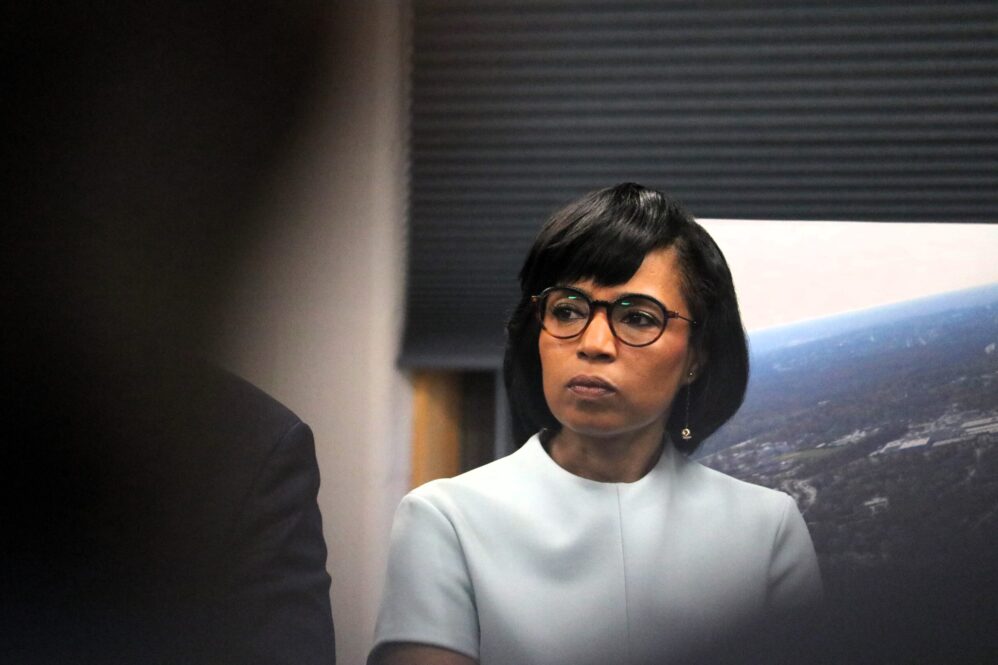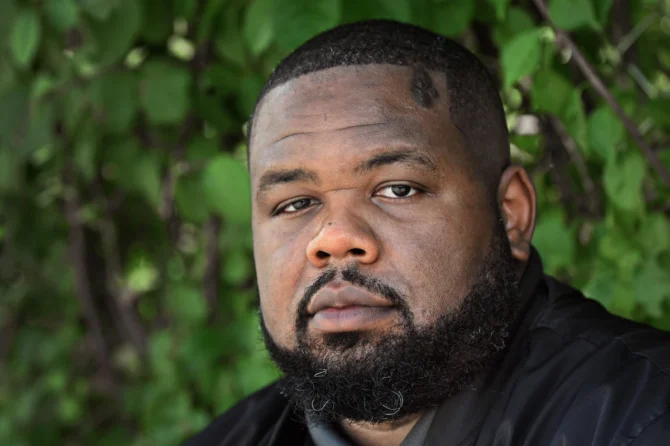MARYLAND MATTERS: Prince George’s County Executive Angela Alsobrooks (D), who has seen her principal opponent in the Democratic Senate primary, U.S. Rep. David Trone, dominate the airwaves for several months, went up with her first TV ad of the campaign Monday.
It’s partially a biographical spot with a few not-so-subtle digs.
The 30-second ad begins with Alsobrooks in half the frame, speaking to the camera, while small mug shots of U.S. senators — all white and mostly male and elderly — pop up on the other side of the screen.
“The average U.S. senator is 64 years old,” Alsobrooks says in the ad. “Worth $16 million. And the last time they went to the grocery store? I’ll let you decide.”
The images then shift, to footage of Alsobrooks talking to her daughter on a stoop, then in a kitchen with her parents, then meeting people in the community.
“I’m Angela Alsobrooks, and that’s not me. As the mom of a teenaged daughter and daughter of aging parents, I know the pressures we all face. That’s why as county executive I’ve worked to create jobs, invest in schools and expand health care. You deserve a senator who understands you and will fight for you. That’s why I approve this message.”
The ad is a stark reminder of how old, white and male the members of the U.S. Senate are — with Alsobrooks clearly offering something different. The ad is also a swipe at Trone, a multimillionaire business executive before he was elected to Congress — and at the likely Republican Senate nominee in Maryland, former Gov. Larry Hogan.
The ad is airing as the Senate campaign reaches something of an inflection point — three months from the May 14 primaries and with the contest shaken up by Hogan’s surprise entry Friday.
Trone, the co-owner of the Total Wine & More national liquor chain, has spent $23 million of his own money so far this election cycle, investing in TV ads and mailers that target key elements of the Democratic electorate. A recent poll taken for his campaign showed him leading Alsobrooks by 11 points — though both campaigns have suggested they expect the margin to close once Alsobrooks begins advertising steadily on TV.
Gina Ford, a spokesperson for the Alsobrooks campaign, said Monday that the ad, created by the national Democratic firm Magnus Pearson Media, was running in the Baltimore TV market. But she would not say how big the campaign’s ad buy is, or how long the ad will be running.
Meanwhile, Hogan’s announcement that he is planning to seek the seat being vacated by U.S. Sen. Ben Cardin (D) has attracted attention well beyond Maryland’s borders. Several national media outlets ran stories about it, and so did the Washington, D.C., political press.
Hogan has kept a low profile since making his announcement Friday, but his newly-opened Senate campaign committee and a political action committee he founded in 2021 called Better Path Forward opened a joint federal fundraising committee Monday called the Hogan Victory Fund. The creation of that campaign entity was first reported Monday evening by the Politico Influence newsletter. Better Path Forward had $11,000 in the bank as of Dec. 31, according to filings with the Federal Election Commission.
While political professionals differ on whether Hogan can win in November — it is a vastly different dynamic than the gubernatorial races he won in 2014 and 2018, for myriad reasons — there is almost universal agreement that his presence in the race, assuming he wins the Republican primary against lesser-known conservative foes, will put a Maryland Senate seat in play for the first time in a long time and will force the Democrats to divert resources here that they’d rather spend in other competitive states.
“If nothing else, he’ll force Democrats to spend money in Maryland they’d prefer to spend on crucial Senate races in Ohio or Montana,” New York magazine political columnist Ed Kilgore wrote. “For that, even Trump-supporting Republicans will be grateful.”
The liberal Daily Kos on Monday put together a list of recent governors who were able to thrive politically in their states even if they were from the opposite party of most of their constituents, but then fell flat when they were running for Senate — a possible cautionary tale for Hogan.
The roster featured former two-term Montana Gov. Steve Bullock (D), who lost a Senate election in 2020 by 10 points, former two-term Tennessee Gov. Phil Bredesen (D), who lost a Senate election in 2018 by 11 points, and former two-term Hawaii Gov. Linda Lingle (R), who lost a Senate race in 2012 by 26 points.
Hogan, for now, has approval ratings far superior to those three former governors — even though all three remained popular until the partisan realities of federal elections in their states collided with their ambitions.
“Governor Hogan is a great leader for Maryland, and that’s why he remains overwhelmingly popular in the state,” said U.S. Sen. Steve Daines (R-Mont.), the chair of the National Republican Senatorial Committee — the man who defeated Bullock in 2020 and who helped recruit Hogan into the Senate race along with Senate Minority Leader Mitch McConnell (R-Ky.). “We look forward to welcoming him to the United States Senate.”
If nothing else, Hogan’s entry into the race may prompt Democratic primary voters to not only think about whether they like Trone or Alsobrooks best, but to consider which would make a stronger general election candidate against the former governor.
Trone’s campaign moved quickly in the wake of Hogan’s announcement to put out a memo arguing that the congressman “remains best positioned to not only win the Democratic nomination but to beat Larry Hogan and Mitch McConnell in November.”











